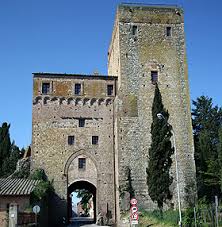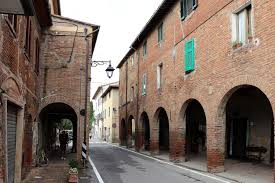Paganico è un piccolo paese della Toscana, in provincia di Grosseto, nel comune di Civitella Paganico. È circondato da colline ricche di boschi, vigneti, oliveti, campi coltivati e case sparse. Il confine fra il comune di Civitella Paganico e il comune di Cinigiano è segnato dal fiume Ombrone, il secondo fiume della Toscana per lunghezza.

Il centro storico
Paganico ha un centro storico delimitato a tratti da mura. Si accede al suo interno attraverso le quattro porte: porta Grossetana, chiamata così perché guarda verso Grosseto; porta Senese che guarda verso Siena; porta Gorella così detta perché prima scorreva in questo luogo un fosso chiamato Gorellino; la porta sull’Ombrone che si affaccia sull’omonimo fiume, oggi è completamente distrutta.
Il centro storico è attraversato dalla strada principale, dalla quale si diramano stradine che si infiltrano in tutti gli spazi della parte vecchia. Gli edifici sono costruiti con mattoni rossastri; c’è una piazza principale e, proseguendo verso la porta Senese, ci sono dei portici, sotto ai quali si svolgono attività commerciali. Continuando, si trova la casa “Santa Caterina”, uno degli edifici più antichi del paese, dove fino al 2003 le suore domenicane hanno gestito un asilo per l’infanzia.
La piazza principale, detta della Vittoria, si trova all’inizio del corso Fagarè, vicino alla porta Grossetana.
Nella piazza si trova la chiesa di S. Michele Arcangelo e un pozzo, che era, ed è ancora, una cisterna per raccogliere l’acqua piovana. Questo pozzo risale al 1300 (circa) ed è stato restaurato negli anni novanta.
Parallela a piazza della Vittoria c’è la “Piazzetta del Leccio”.
Cenni storici
La fondazione di Paganico deve esser ricondotta ai propositi di espansione dei senesi verso il litorale tirrenico. Siena, infatti, nella seconda metà del XIII secolo, vinse la resistenza dei Feudi nobiliari della zona e nel 1262 fu deciso di costruire Paganico, strutturandolo in modo imponente, alla maniera di una città fortezza.
Il 25 dicembre 1292, tre cittadini senesi furono incaricati di progettare la nuova città fortificata.
Per la città fortezza erano previste 150-200 abitazioni, la sede amministrativa per il Capitano, la chiesa, l’edificio doganale (il dazio per il sale), altri edifici fortificati, il tutto finanziato dall’erario.
Ancora oggi il piano dell’insediamento senese si presenta largamente intatto nelle strutture. All’interno delle mura si nascondono, dietro la maggior parte delle facciate modificate nel tempo, originali edifici medievali. Probabilmente l’assegnazione dei terreni per la costruzione degli edifici e per lo sfruttamento agricolo fu conclusa, all’incirca, nell’ultimo decennio del 1200.
La costruzione dell’impianto di fortificazione, invece, procedette a rilento: si sa che nel 1295 esistevano le porte, dato che all’epoca vennero affrescate; ma la costruzione delle mura non andò speditamente, concludendosi nel 1335.
La città fortezza fu promossa, nel 1310, a sede centrale del vicariato di Maremma con la giurisdizione su 24 comuni, ma non raggiunse mai gli scopi per i quali era stata fondata, legata com’era ai destini di Siena, che nel XVI secolo, fu annessa alla Firenze dei Medici.
Nel 1602 Paganico divenne marchesato con Antonio de’ Medici come marchese; Antonio de’ Medici era il figlio naturale di Francesco I de’ Medici.
Nel 1630 il marchesato passò alla famiglia Patrizi fino alla metà del XVIII secolo, quando Pietro Leopoldo di Lorena assunse il controllo diretto del borgo.
Il bombardamento di Paganico del giugno 1944
Durante la seconda guerra mondiale, a Paganico c’era il reggimento d’artiglieria composto da soldati tedeschi; molti militari erano di passaggio per raggiungere il fronte.
Dopo l’8 settembre 1943 e i bombardamenti alleati su Grosseto, Paganico divenne la sede della Prefettura e della Federazione provinciale del PFR.
Il 14 giugno 1944, Paganico subì un primo bombardamento da parte degli Americani. Le bombe furono tirate in direzione dell’attuale Cassero Senese e della Porta Grossetana; la struttura delle porte non fu distrutta perché le bombe colpirono soprattutto le case vicino alle torri. Questi bombardamenti causarono delle vittime. Il reggimento, che intervenne, andò quasi subito in ritirata. I tedeschi, dalla rabbia, con raffiche di mitra, provocarono vittime fra i civili.
Gli ultimi giorni di giugno ci fu l’ultimo bombardamento sulla ferrovia e sul ponte della Gretanessa; furono utilizzate 24 bombe.
The Tourist and the Raiders of the Lost Cafe – Video
Paganico is a small town in Tuscany. It is located in the province of Grosseto in the town of Civitella Paganico. It is in the plains, surrounded by hills full of woods, vineyards, olive groves, cultivated fields and scattered houses. The border between the town of Civitella Paganico and the municipality of Cinigiano is marked by the river Ombrone, the second largest river in Tuscany.
Old Town
Paganico has got a historical center bordered by walls. You enter inside it through the four doors: Grossetana door, so called because it looks towards Grosseto; Senese door looking towards Siena; Gorella door so called because in the past a ditch called Gorellino was in this place; the door on the Ombrone overlooking the river of the same name, today it is completely destroyed.
The old town is crossed by the main road, from which you will pass roads that infiltrate all the spaces of the old part. The buildings are constructed of reddish bricks; there is a main square and, continuing towards the Senese gate, there are porticoes, under which commercial activities take place. Continuing, you will find the “Santa Caterina” house, one of the oldest buildings in the country, where until 2003 the Dominican nuns managed a kindergarten.
The main square, called della Vittoria, is located at the beginning of the Fagaré course, near the Grossetana gate. Inside the square there is a small garden with streets, benches and tables, where people usually stop as customers of the bar in front of them: above all the elderly and tourists. In the garden there is also a war memorial, a statue that represents a military, in memory of people who died in war to defend their country.
In the square there is also the church of S. Michele Arcangelo. In the middle of the square there is a well, which was, and still is, a cistern; it was probably used to collect rainwater. This well dates back to 1300 (approximately) and was restored in the nineties.
Parallel to Piazza della Vittoria is the “Piazzetta del Leccio”, called piazzetta because it is a small square.
Salient Moments of The History of Paganico
The foundation of Paganico must be traced back to the intentions of the Sienese expansion towards the Tyrrhenian coast. Siena, in fact, in the second half of the XIII century, won the resistance of the noble Feuds of the area and in 1262 it was decided to build Paganico, structuring it in an impressive way, in the manner of a fortress city.
On December 25, 1292, three Sienese citizens were commissioned to design the new fortified city.
For the fortress city there were 150-200 houses, the administrative headquarters for the Captain, the church, the customs building (the salt duty), other fortified buildings, all financed by the Treasury.
Even today, the Sienese settlement plan is largely intact in its structures. Inside the walls are hidden behind most of the facades modified over time, original medieval buildings. Probably the allocation of land for the construction of buildings and for agricultural exploitation was completed, approximately, in the last decade of the 1200s.
The construction of the fortification, however, proceeded slowly: we know that in 1295 there were doors, since at that time they were frescoed; but the construction of the walls did not go quickly, ending in 1335.
The fortress city was promoted, in 1310, to the headquarters of the vicariate of Maremma with jurisdiction over 24 municipalities, but never achieved the purposes for which it was founded, linked as it was to the destinies of Siena, which in the sixteenth century, it was annexed to the Florence of the Medici.
In 1602 Paganico became marquisate with Antonio de ‘Medici as marquis; Antonio de ‘Medici was the natural son of Francesco I de’ Medici.
In 1630 the marquisate passed to the Patrizi family until the middle of the eighteenth century, when Pietro Leopoldo di Lorena assumed direct control of the village.
The bombing of Paganico in June 1944
During the Second World War, in Paganico there was an artillery regiment composed of German soldiers; many soldiers were passing through to reach the front.
After September 8, 1943 and the allied bombing of Grosseto, Paganico became the seat of the Prefecture and of the Provincial Federation of the PFR.
On June 14, 1944, Paganico underwent an initial bombardment by the Americans. The bombs were pulled in the direction of the current Cassero Senese and Porta Grossetana; the structure of the doors was not destroyed because the bombs mainly hit the houses near the towers. These bombings caused victims. The regiment, which intervened, almost immediately retreated. The Germans, with anger, with bursts of machine guns, provoked victims among the civilians.
The last days of June there was the last bombing on the railway and on the Gretanessa bridge; 24 bombs were used.

